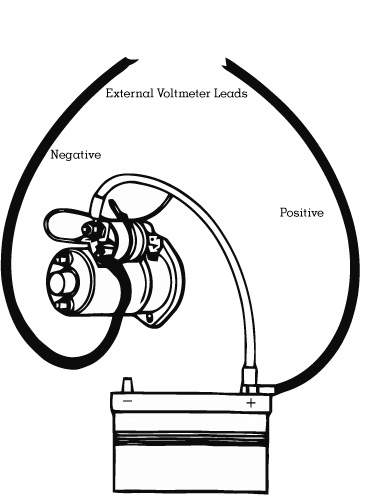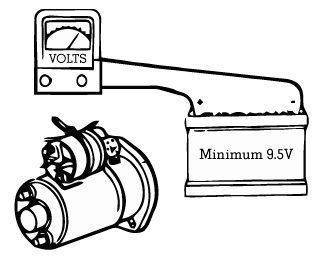Check starter connections
 If the battery passes a load test but the cranking speed is still below 150 rpm there may be a problem with the starter or the starter connections.
If the battery passes a load test but the cranking speed is still below 150 rpm there may be a problem with the starter or the starter connections.
Disconnect wire from the fuel shut-off solenoid and insulate the wire.
Connect a voltmeter between the center of the battery (+) terminal and the starter (+) terminal (field winding) as shown. Make sure the connections are clean and secure.
Crank the engine and observe the voltmeter reading while cranking.
- Switch voltmeter to low scale while cranking to prevent damaging meter.
- If voltmeter reads more than 0.5 volts, there is excessive resistance in the starter cable, its connections, or the connections in the starter solenoid.
 Connect the voltmeter between the center of the battery (-) terminal and the transmission or starter housing as shown. (Scratch through paint if necessary to ensure a good connection).
Connect the voltmeter between the center of the battery (-) terminal and the transmission or starter housing as shown. (Scratch through paint if necessary to ensure a good connection).
Switch voltmeter to low scale.
Crank the engine and observe the voltmeter reading while cranking.
- If the voltmeter reads more than 0.5 volts, there is excessive resistance in the ground cable or its connections between the battery and the transmission. Locate the
problem and repair.
Check starter
 If the battery passed a load test and you have checked for excessive drag in the engine, test the cranking voltage.
If the battery passed a load test and you have checked for excessive drag in the engine, test the cranking voltage.
Connect a voltmeter to the battery.
Crank the engine.
- If the voltmeter reads less than 9.5 volts while the engine is cranking, there is a problem in the starter.
Reconnect the fuel shut-off solenoid.
Before replacing the starter, check the bushing in the transmission housing. If the bushing is worn or dry, extra drag will be put on the starter.
If the starter pinion shaft is bent or broken and the starter was not loose, check the flywheel and replace if it is out of round.
